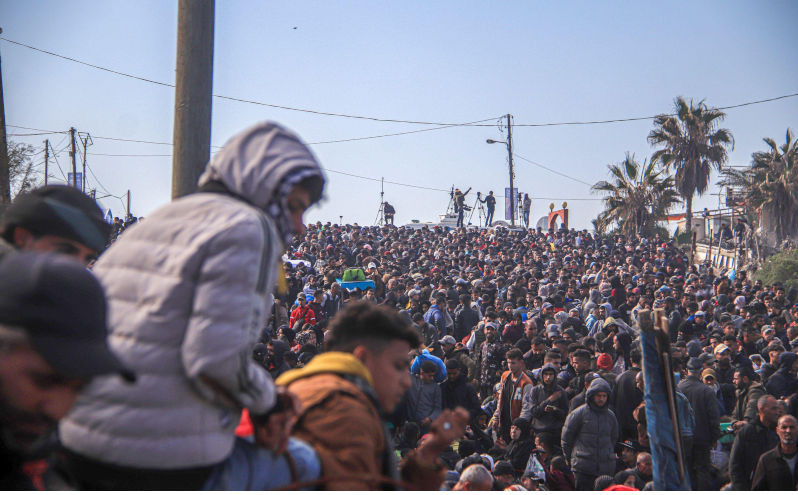Al Jazeera’s reporter Hind Khoudary has in the last few days posted a report documenting her journey back to her home in northern Gaza.
One among hundreds of thousands of Palestinians forming a long human chain along the Al Rasheed road straddling the Gazan coast, Khoudary carries a backpack, her chest covered by her blue press vest, with a microphone attached to record her observations. “Everyone is going home today,” she tells us (I quote from the written transcript of her speech) as she walks, and continues: “It took us a lot of time to reach this area. People are barely holding backpacks. And even me, I’m carrying everything I want in this backpack. This is literally the moment I have been waiting for since the day I got displaced from the Gaza City. And it’s not only me. It’s everyone else here.”
The emphasis she places on her sense of returning home, while no doubt referencing her immediate experience of overcoming her displacement, carries the longer durée of the Nakba, the over eight decades of expulsion of First Nations Palestinians from their indigenous lands by the Israeli settler colony. In French, the term durée does not only refer to a period of time, but also to a people’s awareness of the passing of time; to a people’s narration of time, to their sense of history as both that which has passed and that which can still be made. Hence Khoudary’s joy, her smiles into the camera lens, toward her potential audience: “Everyone is going home today. We know it’s going to be a long journey. But we don’t care as long as we’re gonna reach home. That’s all we want.”
While echoing, since the establishment of the settler colony in 1948, a 76-year Palestinian yearning for a return to their indigenous lands (a right codified in international law by United Nations resolution 194 of December 1948), Khoudary’s determination resounds with the Great March of Return undertaken by Gazan Palestinians in March 2018. At the time, Israel’s occupation army responded to the peaceful march with sniper fire, murdering 150 Palestinians in the first six months of the protest movement challenging the Israeli blockade.
The steadfastness and determination orienting the long Palestinian human chain currently heading back north is informed by these previous movements and protests, with the added value of physically realising an actual return. As many commentators have noted, around 70% of Gaza’s inhabitants are refugees from Israel’s settler program of expropriation of indigenous lands. The very idea of a return resonates with a sense of belonging, in a fraught relationship to a history of displacement.
Panoramic images of the Palestinian trail heading north have an effect of disrupting the Israeli propaganda machine, which serves to portray the indigenous people as somehow having no historic connection to the land. Effectively, the astonishing scale of destruction Israel has unleashed on Gaza in the past 15 months is strategically designed to destroy what we can call Palestinian mnemonic infrastructures. The wanton decimation of cultural centres, municipal buildings (such as Deir Al-Balah in central Gaza on December 4, 2024), universities, hospitals, places of religious worship, as well as sixteen cemeteries—all this involves a plot to dismantle Palestinian heritage, Palestinian archives, the very capacities of Palestinians to anchor themselves in and for history, in and for memory.
The Palestinian durée I mentioned above is eloquently expressed by a speech given to the UN’s Security Council on 29 January 2025, by the Palestinian delegate Riyad Mansour. In his moving words he speaks about the human chain carving out a return to the north, describing “families carrying whatever they can of what remains of who they are.” It is a poignant observation, his voice quivering as he speaks, recognising the historical import of this return, the durée by which Palestinians maintain capacities to breath life into their histories and memories. “Carrying…the remains of who they are”– who they are having to be managed through the Nakba stretching from at least 1948 into the present, who they are acted on and articulated through breathing life into their remains.
To quote further from Mansour’s speech, which brilliantly provides a narrative compliment to the Palestinian return north: “Israel has destroyed everything in Gaza, everything except the sacred bond between a people and their land.” And further: “This image shows their resilience, their steadfastness [in Arabic, sumud, a term Palestinians employ to refer to their unwavering commitment in the face of adversity], their inability to surrender, and just how much they belong to this land, and this land belongs to them. This is the Palestinian struggle: a simple dream living in freedom and dignity in their ancestral land.”
The Palestinian delegate Mansour goes on to list the UN’s resolution 194 I mentioned above, a resolution that still maintains validity. Its historical value does not merely inscribe a past history, but as I have been suggesting comes to gain its eventuating significance in respect to Palestinians maintaining their capacities to breath life (nafs, or breath) into history, passed on and through one generation after another.
In such terms we can appreciate the Palestinian resolve to return north, to act on a return itself, conveyed through Khoudary’s precious images and narrative, expressed through her joyous references to the expansive scene in which she moves, and of which she is a part.

Norman Saadi Nikro
Norman Saadi Nikro has Australian and Lebanese backgrounds. He is a former Australian Volunteer Abroad, serving in the West Bank of Palestine in 1998-99. His books include The Fragmenting Force of Memory: Self, Literary Style,and Civil War in Lebanon (2012); Milieus of ReMemory: Relationalities of Violence, Trauma, andVoice (2019); and Nafssiya: Edward Said’s Affective Phenomenology of Racism (2024). Since July 2024 he resides in Sydney as an independent scholar and writer.
